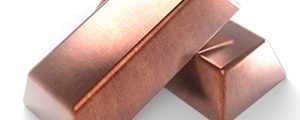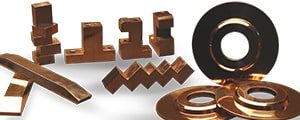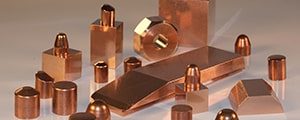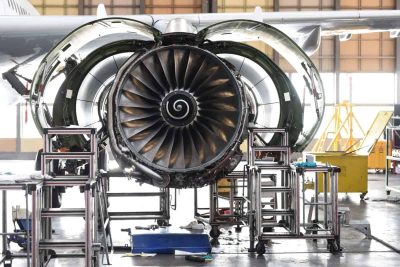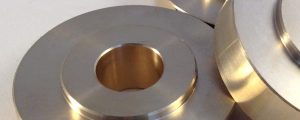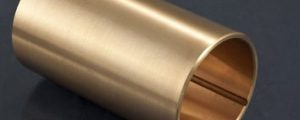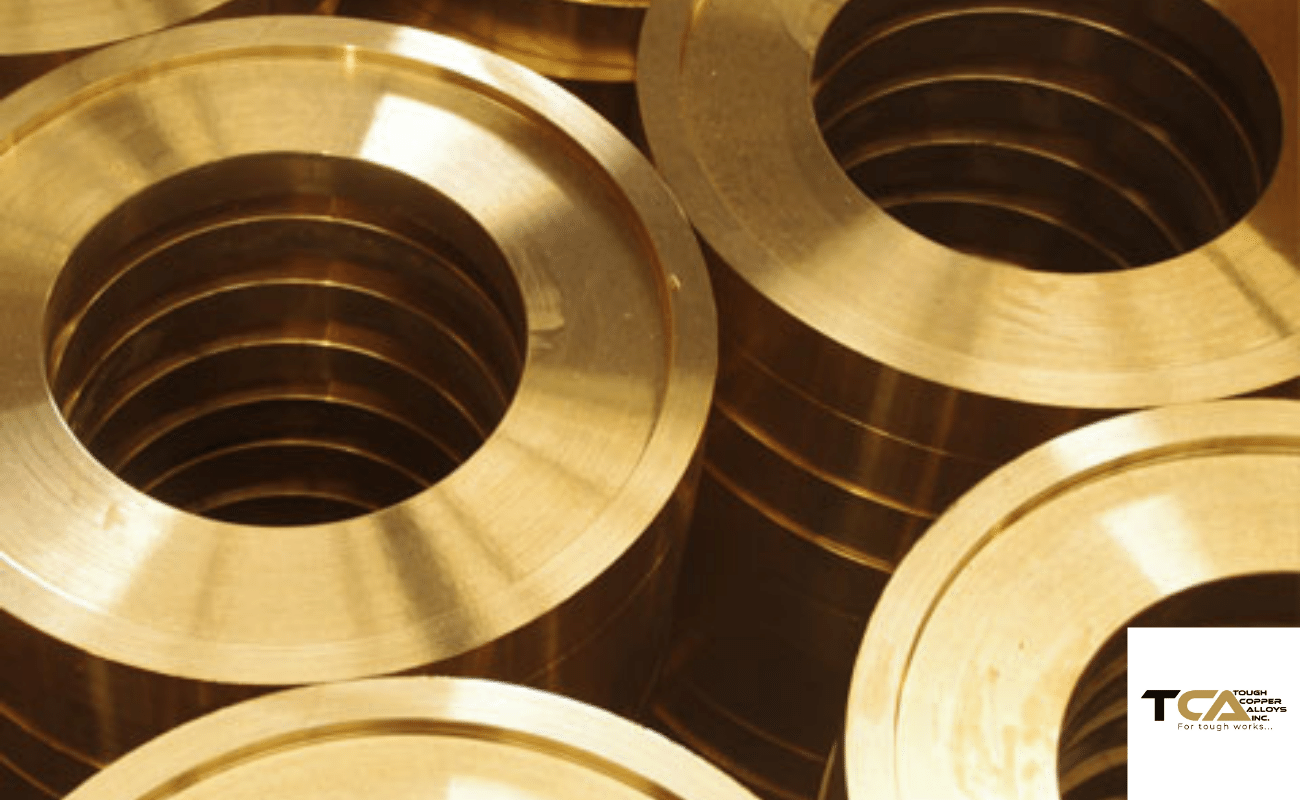What is “C61900” Material?
C61900 is a copper-nickel-aluminum bronze alloy that is known for its excellent strength, wear resistance, and corrosion resistance in seawater and other harsh environments. It is also commonly referred to as C619 and is a member of the family of aluminum bronze alloys.
This material is typically composed of 81% copper, 10% nickel, and 5% aluminum, with the remainder made up of iron, manganese, and other trace elements. It is a high-strength material that is often used in applications where wear resistance and corrosion resistance are critical.
One of the key benefits of C61900 is its exceptional resistance to corrosion in seawater and other harsh environments. This makes it an ideal choice for marine applications, such as shipbuilding, offshore oil and gas drilling, and underwater structures. It is also commonly used in other industries, such as aerospace, defense, and industrial manufacturing, where its combination of strength and corrosion resistance make it a preferred material choice.
In addition to its excellent corrosion and wear resistance, C61900 also offers good machinability and is easy to weld, making it a versatile material choice for a wide range of applications. Its high strength and durability also make it an ideal material for high-stress applications, such as bearings, gears, and valve components.
Overall, C61900 is a highly versatile and durable material that offers exceptional strength and corrosion resistance, making it an ideal choice for a wide range of applications in various industries. Whether you are in need of a material for marine, aerospace, or industrial manufacturing applications, C61900 is an excellent option to consider.
Application Areas & Industries
C61900 is a copper alloy that is highly sought after in a variety of industries due to its unique combination of mechanical and physical properties. Its excellent strength, corrosion resistance, and machinability make it a versatile material that is suitable for use in various applications. Some of the key industries and application areas where C61900 finds use include:
Marine Industry: Due to its excellent resistance to corrosion, C61900 is widely used in the marine industry. It is commonly used to manufacture various components for ships, boats, and other vessels that operate in saltwater environments. It is also used to make marine hardware such as propellers, shafts, and fittings.
Oil and Gas Industry: C61900 is often used in the oil and gas industry for a variety of applications, including valve bodies, pump shafts, and bushings. Its high strength and corrosion resistance make it an ideal material for use in harsh environments.
Aerospace Industry: It is used in the aerospace industry for various applications, including landing gear components and hydraulic system parts. Its excellent strength and resistance to corrosion make it a popular choice in the aerospace industry.
Automotive Industry: C61900 is used in the automotive industry for various applications, including transmission parts, bearings, and gears. Its high strength and wear resistance make it an ideal material for use in the automotive industry.
Construction Industry: It is used in the construction industry for various applications, including the manufacturing of fittings, fasteners, and other components that require high strength and corrosion resistance. It is also used in the construction of electrical equipment, such as switchgear components and bus bars.
Manufacturing Industry: It is a versatile material that is used in the manufacturing industry for various applications, including the manufacturing of complex parts and components. Its excellent machinability and mechanical properties make it a popular choice in the manufacturing industry.
Please note that these are just a few examples of the many application areas and industries for C61900. The specific uses for C61900 may vary depending on the specific alloy composition and manufacturing process. It’s important to consult the manufacturer or supplier for the specific properties of C61900 being used in an application.
Common Fabrication Processes
C61900 is a high-strength copper alloy with excellent corrosion resistance and wear resistance. This material is commonly used in various industries due to its unique properties. To manufacture parts and components from C61900, several fabrication processes are available. Here are some of the most common fabrication processes used for it:
- Hot forging: Hot forging is a process used to shape C61900 into various forms such as bars, billets, and plates. The material is heated to high temperatures and then shaped using a press or hammer.
- Machining: Machining is a process used to remove material from the C61900 workpiece to create the desired shape. This process can be done using a variety of tools such as drills, lathes, and milling machines.
- Welding: It can be welded using various welding techniques such as TIG welding and MIG welding. Welding is a process used to join two or more pieces of C61900 together to create a larger component.
- Brazing: Brazing is a process used to join two or more pieces of C61900 using a filler metal. This process is commonly used to create joints in C61900 pipes and tubes.
- Heat treatment: Heat treatment is a process used to modify the mechanical and physical properties of C61900. The material is heated to a specific temperature and then cooled to achieve the desired properties.
- Annealing: Annealing is a process used to soften C61900 and improve its machinability. The material is heated to a specific temperature and then slowly cooled to room temperature.
By using these fabrication processes, manufacturers can create a variety of C61900 parts and components to meet the requirements of different applications. It’s important to choose the appropriate fabrication process depending on the specific requirements of the application.
Chemical Composition of “C61900”
C61900 is a high-strength copper alloy that is used in various applications due to its excellent mechanical properties and corrosion resistance. The chemical composition of C61900 includes copper (Cu), aluminum (Al), iron (Fe), nickel (Ni), and manganese (Mn). The table below shows the approximate composition:
| Element | Composition (%) |
|---|---|
| Copper (Cu) | 78.0-81.0 |
| Aluminum (Al) | 10.0-11.0 |
| Iron (Fe) | 3.5-5.0 |
| Nickel (Ni) | 2.5-4.5 |
| Manganese (Mn) | 1.5-3.0 |
Copper is the primary element in C61900, with a composition range of 78.0-81.0%. Aluminum is the second most abundant element, with a composition range of 10.0-11.0%. Iron, nickel, and manganese are present in smaller amounts, with composition ranges of 3.5-5.0%, 2.5-4.5%, and 1.5-3.0%, respectively.
The chemical composition of C61900 gives it its unique combination of properties, including high strength, corrosion resistance, and good machinability. It is commonly used in the manufacturing of various components such as bushings, bearings, and gears, as well as in marine and aerospace applications.
It’s important to note that the exact composition of C61900 may vary depending on the manufacturer and specific production process. It’s always best to consult the manufacturer or supplier for the exact chemical composition of the C61900 alloy being used.
Physical Properties
C61900 is a copper alloy that possesses a range of unique physical properties. Understanding these properties is essential for selecting the right material for your specific application. Here are some of the key physical properties:
Density: The density of C61900 is approximately 8.79 g/cm³, which is relatively high compared to other copper alloys.
Melting point: The melting point of C61900 is around 1083°C (1981°F). This is a relatively high melting point for a copper alloy, which makes it suitable for high-temperature applications.
Thermal conductivity: It has excellent thermal conductivity, which makes it an ideal material for use in heat exchangers and other applications that require efficient heat transfer.
Electrical conductivity: It has high electrical conductivity, which makes it suitable for use in electrical components and wiring.
Magnetic properties: C61900 is not magnetic, which makes it an ideal material for use in applications that require non-magnetic properties.
Corrosion resistance: It exhibits excellent corrosion resistance, particularly in seawater environments. This makes it ideal for use in marine applications.
Hardness: C61900 is a relatively hard material, with a typical Rockwell hardness of 78-85 B. This makes it suitable for use in applications that require high strength and wear resistance.
It’s important to note that the physical properties of C61900 may vary depending on the specific alloy composition and manufacturing process. It’s always recommended to consult the manufacturer or supplier for the specific properties of C61900 being used in an application.
Fabrication Properties
- Machinability: C61900 is highly machinable, making it an ideal material for applications that require complex shapes or tight tolerances. It can be machined using a variety of tools and techniques, including turning, drilling, milling, and grinding.
- Weldability: It is also highly weldable. It can be welded using a variety of techniques, including gas tungsten arc welding (GTAW), gas metal arc welding (GMAW), and resistance welding. However, it is important to note that proper welding techniques and precautions must be taken to avoid cracking or other defects.
- Formability: C61900 is easily formed and can be shaped into a variety of configurations. It can be cold worked using techniques such as rolling, bending, and stamping, or it can be hot formed using techniques such as forging and extrusion.
- Heat treatment: It can be heat treated to improve its strength and other mechanical properties. The exact heat treatment process will depend on the specific alloy composition and the desired properties.
Overall, C61900 is a versatile material that is easy to fabricate using a variety of techniques. Its excellent fabrication properties, combined with its desirable mechanical and physical properties, make it a popular choice for a wide range of applications in various industries.
Applicable Specifications
C61900 is a type of copper-nickel-silicon alloy, also known as Nickel Aluminum Bronze (NAB) that is commonly used in various industrial applications due to its excellent mechanical and physical properties. It is important to select the appropriate specifications for the alloy to ensure its optimal performance in specific applications. Here are some of the most common applicable specifications:
ASTM B505: This specification covers copper alloy continuous castings, including C61900, for use in various mechanical applications such as bearings, bushings, and gears.
AMS 4862: This specification covers copper-nickel-tin alloy, such as C61900, in the form of seamless tubing and redraw hollows for use in heat exchangers and other similar applications.
SAE J461: This specification covers copper alloys, including C61900, for use in various industrial applications. The specification defines the chemical composition, mechanical properties, and other requirements for the alloy.
SAE J462: This specification covers testing methods for copper alloys, including C61900, to determine their physical and mechanical properties such as density, conductivity, and tensile strength.
MIL-C-11866: This military specification covers copper-nickel-tin alloy, including C61900, in the form of seamless tubes for use in heat exchangers and other similar applications.
By selecting the appropriate specification for C61900, manufacturers and engineers can ensure that the alloy will meet the necessary requirements for their specific applications. It is important to consult the manufacturer or supplier for the specific properties and applicable specifications of C61900 before using it in any application.
Thermal Properties of “C61900”
C61900, also known as aluminum bronze, is a copper-based alloy that exhibits exceptional thermal properties. These properties make it an ideal material for use in applications that require resistance to high temperatures. Some of the key thermal properties of C61900 include:
Thermal conductivity: C61900 has a high thermal conductivity of approximately 54 W/(m·K), which is higher than many other copper alloys. This property makes it an ideal choice for applications that require efficient heat transfer, such as heat exchangers, cooling systems, and electrical contacts.
Coefficient of thermal expansion: The coefficient of thermal expansion for C61900 is 17 μm/m·K, which is relatively low compared to other copper alloys. This property makes it less susceptible to thermal expansion and contraction, which is important in applications where dimensional stability is critical.
Melting point: The melting point of C61900 is approximately 1020°C, which is higher than many other copper alloys. This property makes it suitable for applications that require high-temperature resistance, such as furnace components and aerospace components.
Specific heat capacity: C61900 has a specific heat capacity of approximately 385 J/(kg·K), which is similar to other copper alloys. This property indicates the amount of heat required to raise the temperature of a given amount of material, which is important in applications such as thermal management.
Overall, the excellent thermal properties of C61900 make it a preferred material for applications that require high-temperature resistance and efficient heat transfer. It’s important to consult with the manufacturer or supplier to ensure that the C61900 alloy being used meets the specific thermal requirements of the intended application.
Typical Uses of “C61900”
C61900 is a popular aluminum bronze alloy that exhibits excellent mechanical, physical, and thermal properties, making it suitable for use in a wide range of applications. Here are some of the typical uses of C61900:
- Marine applications: C61900 is commonly used in marine applications due to its high resistance to corrosion in seawater environments. It is often used in the construction of ship and boat fittings, propellers, and shafts.
- Oil and gas industry: C61900 is also used in the oil and gas industry due to its resistance to corrosion and erosion. It is commonly used to manufacture valves, pumps, and other components that are exposed to corrosive fluids.
- Aerospace industry: C61900 is used in the aerospace industry due to its high strength, wear resistance, and thermal stability. It is often used to manufacture components for aircraft and spacecraft, including bearings, gears, and bushings.
- Electrical industry: C61900 is widely used in the electrical industry due to its excellent electrical conductivity and resistance to corrosion. It is commonly used to manufacture electrical connectors, terminals, and switches.
- Automotive industry: C61900 is also used in the automotive industry for various applications, including the manufacturing of transmission components and other parts that require high strength and wear resistance.
- Industrial equipment: C61900 is used in the manufacturing of a variety of industrial equipment, including machine parts, bearings, and bushings.
Overall, C61900 is a versatile alloy that finds use in various industries due to its excellent properties. Its resistance to corrosion and wear, high strength, and thermal stability make it a preferred material for many applications. It is important to consult with the manufacturer or supplier to ensure that the specific C61900 alloy being used meets the requirements of the intended application.
Equivalents
C61900 is a copper-nickel-aluminum bronze alloy that offers excellent mechanical, corrosion, and thermal properties. However, in some cases, an equivalent alloy may be needed due to availability, cost, or other considerations. Some common equivalents:
- C95800: This is a cast version of aluminum bronze, which has similar properties to C61900. It contains approximately 81% copper, 10% aluminum, 5% nickel, and 4% iron, with trace amounts of other elements.
- C63000: This is a precipitation-hardening nickel-aluminum bronze alloy that contains approximately 81% copper, 10% aluminum, 4% nickel, 4% manganese, and 1% iron, with trace amounts of other elements. It has similar mechanical properties to C61900, but may have slightly different corrosion and thermal properties.
- C95500: This is a wrought version of aluminum bronze that contains approximately 78% copper, 11% aluminum, 5% nickel, and 5% iron, with trace amounts of other elements. It has similar mechanical properties to C61900, but may have slightly different corrosion and thermal properties.
- C62400: This is a nickel-aluminum bronze alloy that contains approximately 78% copper, 10% aluminum, 5% nickel, and 5% iron, with trace amounts of other elements. It has similar mechanical properties to C61900, but may have slightly different corrosion and thermal properties.
It’s important to note that while these alloys may have similar properties to C61900, they may not be exact equivalents. The specific requirements of the intended application should be taken into consideration when selecting an alloy. It’s recommended to consult with the manufacturer or supplier to determine the best alloy for a specific application.

